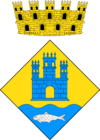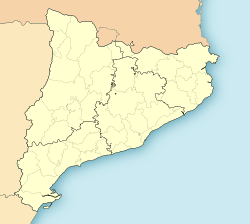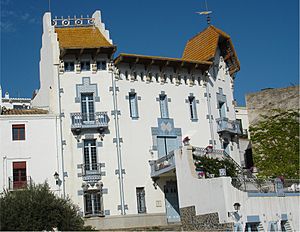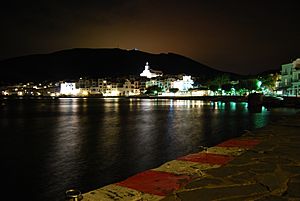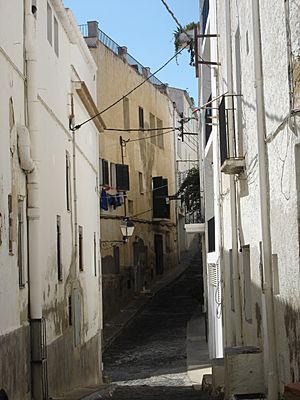Cadaqués facts for kids
Quick facts for kids
Cadaqués
|
||
|---|---|---|
|
Municipality
|
||
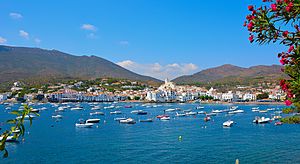 |
||
|
||
| Country | ||
| Autonomous community | ||
| Province | ||
| Comarca | Alt Empordà | |
| Area | ||
| • Total | 26.4 km2 (10.2 sq mi) | |
| Elevation | 23 m (75 ft) | |
| Population
(2018)
|
||
| • Total | 2,752 | |
| • Density | 104.24/km2 (270.0/sq mi) | |
| Demonym(s) | Cadaquesenc | |
Cadaqués is a charming town located in Catalonia, Spain. It sits on a beautiful bay in the middle of the Cap de Creus peninsula, right on the Costa Brava (which means "Wild Coast") of the Mediterranean Sea. Even though its official population was about 2,752 people in 2018, many more visitors come during the summer, making it a lively place!
This town is famous for its connection to art. Many well-known artists, like Salvador Dalí, Pablo Picasso, and Joan Miró, have spent time here. Dalí even had a home in a small village next to Cadaqués called Port Lligat. The unique beauty of Cadaqués has inspired many creative minds throughout history.
Long ago, a Jewish community lived here during the medieval period. You can still visit the old Jewish quarter in Cadaqués today. The town also has a fun traveling market on Mondays, where you can find all sorts of interesting products.
Contents
What's in a Name?
The name Cadaqués comes from the Catalan words "Cap de quers," which means "Cape of Rocks." In old documents, you might see it spelled as Cadaqués or Cadaquers. This name perfectly describes the rocky coastline of the area.
A Look at History
Cadaqués and Cuba
In the early 1900s, many people from Cadaqués traveled or moved to Cuba. It's believed that about one-third of the village's population, which was around 1200 people at the time, went to Cuba. Many of them became very successful there and later returned to Cadaqués.
When they came back, they built large, fancy houses that you can still see in the town today. One famous example is the "Casa Blava," which means "Blue House." People who returned from Cuba were often called "Americanos."
Old Traditions
Traditionally, women in the village would carry water using a special glazed earthenware jug called a "doll." These jugs were usually green. You can still see similar earthenware used as decorations today. Old photos show women carrying these "dolls" on their heads, often with a protective cloth.
Because Cadaqués is close to the French border and was quite isolated by land, it had a history of people running contraband (illegal goods).
Famous People Who Loved Cadaqués
Many famous artists, writers, and musicians have visited or lived in Cadaqués, drawn by its unique charm. Here are just a few:
- Salvador Dalí: The famous surrealist painter, who had a house in nearby Port Lligat.
- Pablo Picasso: Another legendary artist who stayed in Cadaqués.
- Joan Miró: A well-known Spanish painter.
- Marcel Duchamp: An influential artist who enjoyed playing chess in a local cafe.
- Federico García Lorca: A celebrated Spanish poet and playwright.
- Walt Disney: Yes, even the creator of Mickey Mouse visited Cadaqués!
- James Mason: A famous actor who filmed near Cadaqués.
- Pablo Casals: A world-renowned cellist.
- Niki de Saint Phalle: A French artist known for her colorful sculptures.
- Richard Hamilton: An English artist.
- John Cage: A famous composer.
- Josep Pla: A Catalan writer who wrote many books about Cadaqués.
A Special Way of Speaking
Even though Spanish is spoken in Cadaqués, the village has its own special way of speaking Catalan, called "cadaquesenc." It's a unique dialect!
One interesting thing about this dialect is that it uses different words for "the" (like "sa" for feminine and "es" for masculine) compared to standard Catalan. This is similar to the Catalan spoken in the Balearic Islands. This is because long ago, people from the Cadaqués region helped settle those islands, and their old way of speaking was preserved in both places because Cadaqués was quite isolated.
The "cadaquesenc" dialect also has many unique words for things found in the village:
- rastell: A steep street made of vertical slate stones, very common in Cadaqués.
- grop: A black rain cloud.
- llagut: A small boat.
- talaia: An elevated lookout point or castle used to warn the village of danger.
- xarxi: A fishing net (different from the standard Catalan word).
- Norai: A stone building where fishermen tied their boats.
Exploring Cadaqués
Main Sights to See
- Salvador Dalí House-Museum: You can visit the home of the famous artist, which is now a museum.
- Church of St. Mary: This beautiful church from the late 1600s stands out in views of the town.
- Natural Park of Cap de Creus: This park is home to amazing landscapes and a lighthouse at the easternmost point of mainland Spain.
Hiking Adventures
If you love hiking, Cadaqués is a great starting point! The GR 92 is a long-distance walking path that follows the Mediterranean coast of Spain. You can hike north from Cadaqués to Llançà (about 20.3 km) or south to Roses, Girona (about 21.7 km).
The Rocks of Cadaqués
The beautiful landscape around Cadaqués, especially in the Cap de Creus peninsula, is shaped by its interesting geology. The rocks here were formed when the Pyrenees mountains were created. They are mostly metamorphic rocks called schists, which look golden in the sun.
This area is known as the "Wild Coast" for a reason! In winter, strong winds called the Tramuntana blow off the mountains, and the sea can be very rough. This constant wind and sea erosion have shaped the unique rock formations you see today. Geologists love to study this area because its history is so clearly visible in the rocks.
A Copy in China
In 2010, a Chinese company announced plans to build a nearly exact copy of Cadaqués in China! This replica village, called Kadakaisi, is being built on a large piece of land in Xiamen Bay and is meant to house many Chinese holidaymakers. Construction was still ongoing in 2017.
Images for kids
See also
 In Spanish: Cadaqués para niños
In Spanish: Cadaqués para niños


